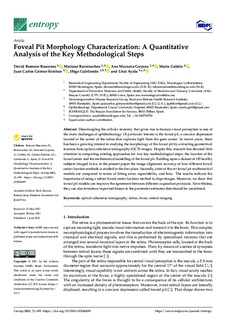| dc.rights.license | Attribution 4.0 International | * |
| dc.contributor.author | Romero-Bascones, David | |
| dc.contributor.author | Barrenechea, Maitane | |
| dc.contributor.author | Ayala, Unai | |
| dc.contributor.other | Murueta Goyena, Ane | |
| dc.contributor.other | Galdós, Marta | |
| dc.contributor.other | Gómez Esteban, Juan Carlos | |
| dc.contributor.other | Gabilondo Cuellar, Iñigo | |
| dc.date.accessioned | 2021-06-04T13:03:14Z | |
| dc.date.available | 2021-06-04T13:03:14Z | |
| dc.date.issued | 2021 | |
| dc.identifier.issn | 1099-4300 | en |
| dc.identifier.other | https://katalogoa.mondragon.edu/janium-bin/janium_login_opac.pl?find&ficha_no=163729 | en |
| dc.identifier.uri | https://hdl.handle.net/20.500.11984/5310 | |
| dc.description.abstract | Disentangling the cellular anatomy that gives rise to human visual perception is one of the main challenges of ophthalmology. Of particular interest is the foveal pit, a concave depression located at the center of the retina that captures light from the gaze center. In recent years, there has been a growing interest in studying the morphology of the foveal pit by extracting geometrical features from optical coherence tomography (OCT) images. Despite this, research has devoted little attention to comparing existing approaches for two key methodological steps: the location of the foveal center and the mathematical modelling of the foveal pit. Building upon a dataset of 185 healthy subjects imaged twice, in the present paper the image alignment accuracy of four different foveal center location methods is studied in the first place. Secondly, state-of-the-art foveal pit mathematical models are compared in terms of fitting error, repeatability, and bias. The results indicate the importance of using a robust foveal center location method to align images. Moreover, we show that foveal pit models can improve the agreement between different acquisition protocols. Nevertheless, they can also introduce important biases in the parameter estimates that should be considered. | es |
| dc.description.sponsorship | Gobierno Vasco | es |
| dc.language.iso | eng | en |
| dc.publisher | MDPI | en |
| dc.rights | © 2021 by the authors. Licensee MDPI | en |
| dc.rights.uri | http://creativecommons.org/licenses/by/4.0/ | * |
| dc.subject | optical coherence tomography | en |
| dc.subject | retina | en |
| dc.subject | fovea | en |
| dc.subject | retinal imaging | en |
| dc.title | Foveal Pit Morphology Characterization: A Quantitative Analysis of the Key Methodological Steps | en |
| dc.type | http://purl.org/coar/resource_type/c_6501 | |
| dcterms.accessRights | http://purl.org/coar/access_right/c_abf2 | en |
| dcterms.source | Entropy | en |
| local.contributor.group | Teoría de la señal y comunicaciones | es |
| local.description.peerreviewed | true | en |
| local.identifier.doi | https://doi.org/10.3390/e23060699 | en |
| local.relation.projectID | GV/Ayudas a proyectos de investigación y desarrollo en salud 2020/2020333033/CAPV/Aplicación clínica de la inteligencia artificial sobre imágenes de OCT de retina para la clasificación precoz y monitorización de pacientes con enfermedad de Parkinson/OCT | en |
| local.rights.publicationfee | APC | en |
| local.rights.publicationfeeamount | 810 EUR | en |
| local.contributor.otherinstitution | https://ror.org/000xsnr85 | es |
| local.contributor.otherinstitution | https://ror.org/0061s4v88 | es |
| local.contributor.otherinstitution | https://ror.org/03nzegx43 | es |
| local.contributor.otherinstitution | https://ror.org/01cc3fy72 | es |
| local.source.details | Vol. 23. N. 6. N. artículo 699, 2021 | en |
| oaire.format.mimetype | application/pdf | |
| oaire.file | $DSPACE\assetstore | |
| oaire.resourceType | http://purl.org/coar/resource_type/c_6501 | en |
| oaire.version | http://purl.org/coar/version/c_970fb48d4fbd8a85 | en |








